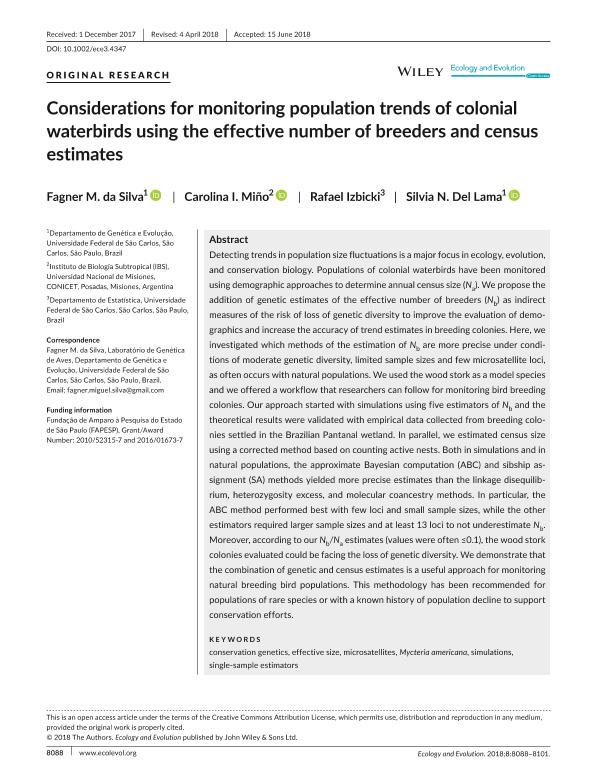Artículo
Considerations for monitoring population trends of colonial waterbirds using the effective number of breeders and census estimates
Fecha de publicación:
06/2018
Editorial:
Wiley
Revista:
Ecology and Evolution
ISSN:
2045-7758
e-ISSN:
2045-7758
Idioma:
Inglés
Tipo de recurso:
Artículo publicado
Clasificación temática:
Resumen
Detecting trends in population size fluctuations is a major focus in ecology, evolution,and conservation biology. Populations of colonial waterbirds have been monitoredusing demographic approaches to determine annual census size (Na). We propose theaddition of genetic estimates of the effective number of breeders (Nb) as indirectmeasures of the risk of loss of genetic diversity to improve the evaluation of demographics and increase the accuracy of trend estimates in breeding colonies. Here, weinvestigated which methods of the estimation of Nb are more precise under conditions of moderate genetic diversity, limited sample sizes and few microsatellite loci,as often occurs with natural populations. We used the wood stork as a model speciesand we offered a workflow that researchers can follow for monitoring bird breedingcolonies. Our approach started with simulations using five estimators of Nb and thetheoretical results were validated with empirical data collected from breeding colonies settled in the Brazilian Pantanal wetland. In parallel, we estimated census sizeusing a corrected method based on counting active nests. Both in simulations and innatural populations, the approximate Bayesian computation (ABC) and sibship assignment (SA) methods yielded more precise estimates than the linkage disequilibrium, heterozygosity excess, and molecular coancestry methods. In particular, theABC method performed best with few loci and small sample sizes, while the otherestimators required larger sample sizes and at least 13 loci to not underestimate Nb.Moreover, according to our Nb/Na estimates (values were often =0.1), the wood storkcolonies evaluated could be facing the loss of genetic diversity. We demonstrate thatthe combination of genetic and census estimates is a useful approach for monitoringnatural breeding bird populations. This methodology has been recommended forpopulations of rare species or with a known history of population decline to supportconservation efforts.
Archivos asociados
Licencia
Identificadores
Colecciones
Articulos(CCT - NORDESTE)
Articulos de CTRO.CIENTIFICO TECNOL.CONICET - NORDESTE
Articulos de CTRO.CIENTIFICO TECNOL.CONICET - NORDESTE
Articulos(IBS)
Articulos de INSTITUTO DE BIOLOGIA SUBTROPICAL
Articulos de INSTITUTO DE BIOLOGIA SUBTROPICAL
Citación
Da Silva, Fagner M.; Miño, Carolina Isabel; Izbicki, Rafael; Del Lama, Sílvia Nassif; Considerations for monitoring population trends of colonial waterbirds using the effective number of breeders and census estimates; Wiley; Ecology and Evolution; 8; 16; 6-2018; 8088-8101
Compartir
Altmétricas




